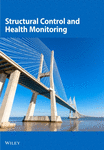Spatial Dynamic Early Warning of Different Positions in Underwater Tunnel Driven by Real-Time Monitoring Data
Abstract
Research on early warning of tunnel anomalies is fundamental for achieving intelligent management. However, most current methods for determining early-warning values of tunnel mechanics indicators are different to couple the nonlinear variation property and spatial positional difference. Therefore, this research presents a novel approach to tunnel early warning based on deep autoregressive learning method (DL-AR) that considers the spatiotemporal correlations of structural mechanics responses, specifically tailored to dynamically determine the warning thresholds at different spatial positions. The methodology introduces a framework for predictive modeling and instantiates it on a typical underwater shield tunnel. After thoroughly learning the temporal and spatial correlations of structural mechanical responses, accurate predictions are made for the evolving trends of structural behaviors and the probabilities to the reasonable fluctuation range. Based on these predictions, spatially varying alert thresholds for structural behaviors are proposed. To ensure the reliability of the proposed model, a series of discussions and validation experiments are conducted. Results indicate that the proposed model effectively captured the spatiotemporal characteristics of structural evolution and identified alert ranges, defining permissible variations in structural trends. The prediction results showed near to 99% consistency with actual data, a 5% enhancement compared to classical models. Any deviation beyond this range triggers an early warning, demonstrating the efficacy of model in anticipating and responding to potential structural issues.
1. Introduction
Tunnels constitute vital components of transportation systems, facilitating connectivity and promoting economic development [1, 2]. Due to the effects of complex geological and operational conditions, tunnel structures are subjected to diverse and dynamic forces, necessitating continuous monitoring for structural health [3, 4]. The imperative of ensuring tunnel safety and mitigating potential risks has led to the emergence of tunnel early-warning research based on the massive number of monitoring data. By proactively identifying potential anomalies and structural issues, it enables timely intervention, preventing disasters, and ensuring the long-term stability of tunnel structures [5, 6]. This research of early warning is essential for enhancing the resilience and reliability of tunnel structural health monitoring (SHM) systems, minimizing risks, and ultimately contributing to sustainable urban development and transportation safety.
Tunnel early-warning research operates at the intersection of structural engineering, data science, and risk management [7–9]. The goal is to fortify existing monitoring systems with predictive capabilities, enabling timely response to emerging structural anomalies [10]. Early-tunnel-warning methods primarily relied on approaches such as statistics, fuzzy mathematics, and expert systems [11, 12]. These methods often require the determination of a necessary safety factor, but there is currently no universal method or basis for determining this factor, and empirical or semi-empirical theories play a significant role during this process. Consequently, when faced with complex working conditions or changes in those conditions, the precision of these methods is significantly reduced. Since numerical simulation methods can effectively model the mechanical response characteristics of structures under complex conditions, applying extreme load conditions to numerical models has become a new approach to determine warning thresholds [13]. However, simplifications and assumptions made during the modeling process lead to a certain degree of deviation between the numerical results and real values. With the continuous development of artificial intelligence technologies, developing data-driven warning models has become a current trend [14, 15]. Some researches focused on data-based have been reported to achieve this goal [16, 17]. For example, the principal component analysis method has been widely used to identify the key disaster-causing factors during the failure process of rocks [18], and the anomaly detection in long-term tunnel deformation monitoring [19]. The support vector machines had been adopted for risk evaluation of tunnel convergence based on the prediction results [20].
These researches made great effort in promoting the development of early-warning system. However, the challenges in tunnel early-warning research are multifaceted [21, 22]. These methods still lack sufficient capability to learn the nonlinear mechanical response characteristics of structures, and the absence of physical mechanism constraints results in insufficient learning of the hidden spatiotemporal correlations in the data. As a result, the level of intelligence in current tunnel warning methods urgently needs further improvement [23]. Specifically, the early-warning values reliant on data-based are usually set to a constant, which are insufficient in addressing the dynamic and evolving nature of tunnel environments. In fact, the mechanical responses of tunnel structure are nonlinear with period variation trend [24, 25], as shown in Figure 1. Therefore, the early-warning system would be failure using a constraint early value if a significant anomaly occurred but its amplitude is not enough to exceed the early-warning value. Additionally, previous research has generally been limited to warning only one spatial position of tunnel structure. However, the variation magnitude of tunnel structure varied with spatial positions, as shown in Figures 1(a) and 1(b). The early-warning analysis aimed to the spatial difference is rarely reported. Hence, a paradigm shift toward real-time monitoring, data-driven algorithm, and mechanical responses characteristics has become imperative in tunnel early-warning analysis [26].
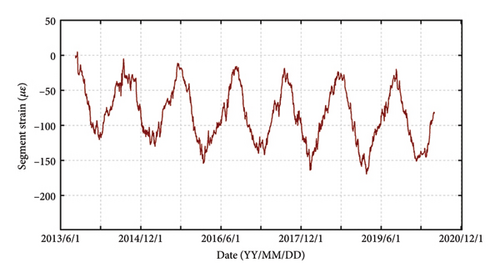
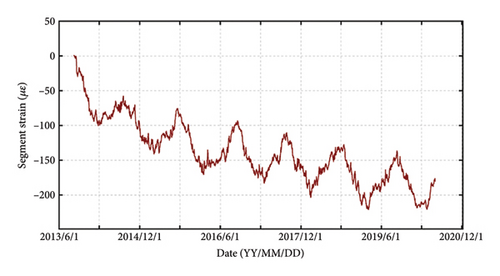
- •
A dynamic early-warning method that considers the nonlinear and spatiotemporal correlations of structural mechanics responses is presented.
- •
Accurately predicted the evolving trends of tunnel structural mechanical properties and the possible states under various environmental cases.
- •
Provided location-specific early-warning thresholds, enhancing the precision of the early-warning system in tunnel structure.
Initially, the framework and methodology of the proposed model are introduced and formulated using monitoring data acquired from a representative underwater shield tunnel. Subsequently, accurate predictions are made for the evolving trends of structural behaviors and their corresponding probabilities by incorporating insights gained from the temporal and spatial correlations of structural mechanical responses. Ultimately, differentiated alert thresholds for different spatial positions are determined based on these predictions. Furthermore, a set of variation experiments is undertaken to validate the robustness and reliability of the proposed model. Through the convergence of cutting-edge technologies and interdisciplinary collaboration, this research devoted to identify potential anomalies of tunnel structure before they threaten the integrity of these vital components of urban transportation systems, striving to promote the intelligent level of tunnel management.
2. Proposed Model
In this section, the problem of spatial dynamic early warning was formalized firstly. Then, the framework to solve this problem was presented, and the methodology in framework was introduced in detail. To describe the proposed model, all notations used in this paper are listed in Table 1.
| Notations | Comments |
|---|---|
| , | Raw measurement and prediction value for sensori at timet |
| , | ρ-quantile predicted value and the median for sensor i at time t |
| Data matrix from m sensors; each sensor provides a time series of length N | |
| N, g, q | Length of each time series, observation window, and future days for prediction |
| m | Total number of sensors (time series) |
| ri | Raw positional label for sensor i |
| r = (r1, r2, … , rm) | Collection of raw positional labels for all sensors. |
| Embedded feature vector with d dimension for sensor i after position encoding. | |
| Embedding matrix formed by stacking the embedded feature vectors of all sensors (each row corresponds to a sensor). | |
| Encoded sensor measurement at time t, combining raw data and positional features. | |
| k | Number of sampling iterations used in the cyclic sampling module. |
| , | Mapping function from historical data to the future conditional distribution parameters. |
| Conditional probability distribution function. | |
| Mean and standard deviation parameters of for sensor i at time t. | |
| δ(·) | Sigmoid activation function used in LSTM gates. |
| ht | Hidden state of the LSTM at time t. |
| ft, it, , Ct, ot | Forget gate, input gate, new cell state, current cell state, and output gate of LSTM. |
| W, b | Weight matrices and bias terms. |
| Mean Absolute Error loss function. | |
| Likelihood loss function based on the log-probability density function. | |
| Overall objective function, integrating and . | |
| λ | Regularization parameter in the objective function. |
| ρ | Quantile level used in the ρ-risk metric. |
2.1. Formalization of Dynamic Spatial Early Warning
Considering that the mechanical responses of tunnel structures at different locations have spatial differences, which can be found from the difference of fluctuation magnitude of monitoring data, as shown in Figure 1, it is necessary to encode the location information of sensors installed in the tunnel structures. For example, the positional information of sensor i can be encoded as ei, the positional information of all sensors is represented as E = (e1, e2, …em). This facilitates the model in learning the relationship between location information and monitoring data, thereby achieving more precise predictions.
The established prediction model, as expressed in Equation (2), is a deep autoregressive learning model that can capture the temporal dynamics within individual sensors, as well as the spatial relationships among sensors, including learning the spatial correlations among different sensors. Therefore, this model is named DL-AR.
2.2. Framework of the Prewarning Method
A prewarning model comprises three main components: position encoding module, conditional distribution prediction module, and cyclic sampling module based on predicted mean and variance, which was proposed. The structure of DL-AR model, which is supposed to capture the temporal relationships inherent in the sensors and the correlated information among different positions, is shown in Figure 2.

2.3. Methodology of the Proposed Model
2.3.1. Deep Autoregression Algorithm DL-AR
In essence, the DL-AR model is an enhanced LSTM method. LSTM method is a kind of recurrent neural network (RNN). The emergence of LSTM networks addresses the problems of gradient vanishing and exploding existed in the classical RNN model by introducing gating units, forget gates, and cell states to regulate the flow of information [27, 28]. This method is superior to handle long sequential data and capturing long-term dependencies [29], so that it was adopted in this study to capture the temporal correlations and predict the future evaluation trend of tunnel structure. The prediction process of DL-AR model is displayed in Figure 3.
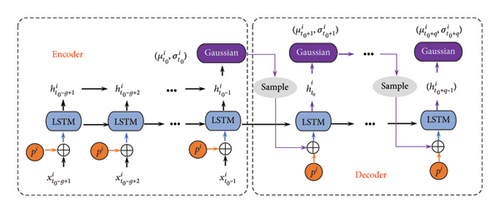
Based on the values of μt and σt, Gaussian distribution was developed to obtain the current prediction results through random sampling. Subsequently, this value serves as the input according to Equation (3) for the prediction of next moment, recursively predicting the output at t + 1 moment until the entire prediction range concludes. To obtain the entire sampling result and derive the probability distribution, the entire decoding phase would iterate k times using the ht−1 from the conditioning range for prediction. Statistics are then conducted on the different random results to represent the probability distribution.
2.3.2. Optimization for Objective Function
To ensure that the predicted distribution fits the prediction range more effectively, a specific objective function should be designed to maximize both the likelihood of the sample data and the probability of the samples in the prediction range.
2.3.3. Evaluation Metrics for Model Performance
Two metrics are used in this work to evaluate the performance of the proposed method, including root-mean-square error (RMSE) and Pearson correlation coefficient (PCC).
3. Background for a River Tunnel
As a case study, we utilized monitoring data from a SHM system installed in a representative underwater shield tunnel to instantiate the DL-AR model. This section introduces the dataset sources, encompassing geological conditions and the monitoring scheme.
3.1. Geological Conditions
The Wuhan Yangtze River Tunnel, situated in Hubei, China, stands as the first underwater shield tunnel crossing the Yangtze River. The tunnel comprises two lines, east line and west line, with a total length of 3.63 km, incorporating a 1080-m land connection segment and a 2550-m river-crossing segment. The geological conditions in the area exhibit significant variations in longitudinal load. Specifically, the river-crossing section encounters primary geological layers, including clay, silty clay, silt, silty-fine sand, medium-coarse sand, pebble, and pelitic siltstone mixed sand shale. Approximately 80% of the tunnel is excavated in silty-fine sand, medium-coarse sand, and pebble, as shown in Figure 4. The tunnel is constructed using segmental lining, with external and internal diameters of 11 and 10 m, respectively. Owing to factors such as high water pressure and complex ground conditions, the tunnel is prone to structural issues during its long-term operation.

3.2. Real-Time Monitoring in the Site
To assess the operational safety of the lining structure and implement the intelligent management of the Wuhan Yangtze River Tunnel, a SHM system has been deployed in the field. This system comprises 12 monitoring sections, with six sections on each of the east and west lines, and their locations and geological characteristics are depicted in Figure 5 and Table 2. Additionally, at each monitoring section, four strain gauges are installed, with two positioned on the arch crown and two on the arch shoulder, as shown in Figure 6. The system commenced service in July 2013, and to date, it has been operating smoothly, providing reliable real-time monitoring data for structural stability analysis and alertness studies.

| Section number | Characteristics |
|---|---|
| W1 and E1 | On the side of the Hankou bank, where the strata change greatly |
| W2 and E2 | Abrupt change in the longitudinal slope o near to Hankou bank |
| W2 and E2 | Flat section of the shield in the center of river |
| W2 and E2 | Minimum overburden in the center of river |
| W2 and E2 | Abrupt change in the longitudinal slope near to Wuchang bank |
| W2 and E2 | Large slope and near the land side |
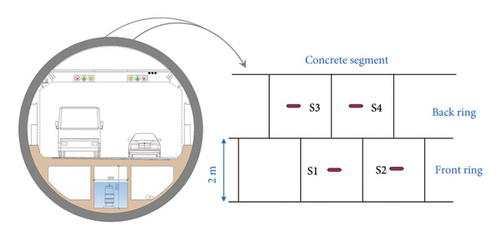
The monitoring data obtained from the SHM system of Wuhan Yangtze River tunnel were adopted to conduct experiments. As an example, the strain monitoring data in one section, from June 1, 2019, to May 20, 2020, were derived with a sampling frequency of one day. Therefore, the monitoring dataset used for experiment contains four time series, and each time series contains 335 samples, expressed as X ∈ R4×335.
4. Prediction of the Future Mechanical Behaviors of Tunnel Structure
In this section, the proposed DL-AR model was instantized on the strain monitoring data obtained from the study case to predict the evolution trend of tunnel structure. To verify the reliability of the predicted results, the robustness and superiority of the DL-AR model were discussed, respectively.
4.1. Preparation of Data Experiment
The original monitoring data obtained from the SHM system underwent preprocessing before being inputted into the proposed DL-AR model. Initially, the data were chronologically divided into three sets: a training set, a validation set, and a testing set, with ratios of 7:1.5:1.5. Subsequently, the time series within each set was separated into multiple sliding windows with a step size of 1. Each sliding window had a length of 28, where the data from the preceding 14 days (g value) were used to predict the following 14 days (q value). Additionally, normalization processing was applied to the data within each window, and they were labeled based on the location information of each sensor.
The embedding layer, responsible for transforming features in the input sequence into a dense vector, was designed with an input dimension of 1 and an output dimension of 32. It means that the positional information was encoded into to a matrix with 32 features, so that the embedding information fed into the LSTM cell is a matrix of 33 dimension. A two-layer LSTM model was developed, with the dimension of the hidden layer set to 64, and a dropout of 0.1 was applied to mitigate overfitting. The input dimension for the linear layer in the cyclic sampling module matched that of the hidden layer, while the output dimension was set to 1. Moreover, the batch size, representing the number of sliding windows fed into the model each time, was set to 64. The learning rate of model was 0.001, with iterations set to 200 and patience set to 10. This indicates that the model would terminate if the loss value does not decrease for 10 consecutive cycles or if the total number of iterations exceeds 200.
4.2. Reasonability for Model Internal Structure
One of the highlights of the proposed model is the consideration of the spatial heterogeneity effect on the mechanical response of tunnel structures, thereby enhancing traditional warning methods. To demonstrate the validity of incorporating spatial heterogeneity, a prediction model named “NoID” is established, which disregards this factor. The structure of this model is identical to the DL-AR model, except for the direct input of monitoring data into LSTM for encoding learning in the former, compared to the spatial feature learning conducted prior to inputting data into the LSTM model in the latter. This indicated that the input information of NoID model is . Furthermore, the hyperparameter settings remain consistent between the two models. Taking forecast time scales of 3, 7, 10, and 14 days as examples, the impact of spatial heterogeneity on the predictive capabilities of these two models is illustrated in Figure 7. It is evident that while the predictive abilities of both models diminish with increasing forecast time scales, the agreement between the predictions of the DL-AR model and the actual states surpasses that of the NoID model at any time scale, with lower errors. Specifically, the error is decreased as least 2 με while the correlations improved over 0.3% after considering the spatial heterogeneity effect, and the superiority of the model becomes more obvious with the increase of prediction time scale. Consequently, spatial heterogeneity emerges as a crucial factor in the structural mechanical response, significantly enhancing the predictive capability of the model when considered.
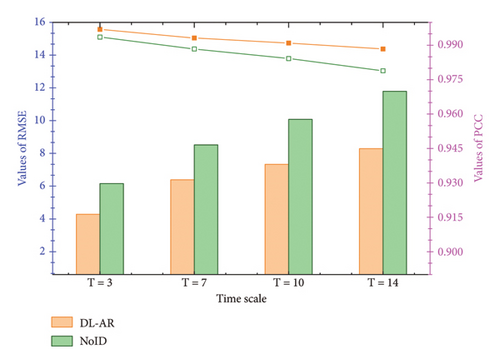
4.3. Reliability With Other Commonly Used Methods
To validate the reliability of the presented DL-AR model, a comparison analysis is conducted with widely used models, including RNN, classical long short-term memory (LSTM), gated recurrent unit (GRU), and support vector regression (SVR). The data experiments of all models under multiple time scales (ranging from 1 to 14 with a step of 1) are carried out, and the experimental results are displayed in Figure 8. The box boundary represents the distribution range of error and correlations of different models, where a larger range indicates poorer stability and lower robustness of the model. Additionally, the red label represents the average RMSE and PCC values for each model across the 14 time scales. Clearly, the DL-AR model is more stable than others, with the smallest RMSE and PCC ranges among all models.
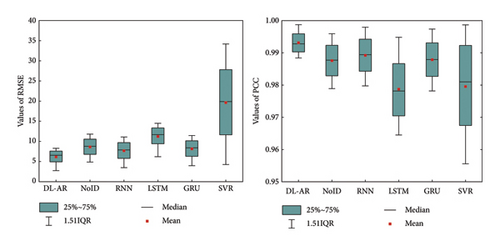
Furthermore, specific evaluation results for the predictive capabilities of different models at time scales of 3, 7, 10, and 14 are derived, as depicted in Figure 9. It is evident that all models exhibit similar characteristics, with predictive performance declining as the time scale increases. However, the predictive ability of the DL-AR model stands out significantly compared to others. The consistency between the prediction results with the actual data is near to 99% even under the prediction scale of 14 days. The RNN model follows closely behind DL-AR, benefitting from its adeptness at capturing temporal correlations and excelling in short-term learning. Conversely, the predictive ability of the SVR model is the weakest, indicating challenges in capturing the complex temporal and spatial correlations inherent in the time series data. In contrast to SVR model, the consistency of DL-AR model improved about 5%. Consequently, the proposed DL-AR model emerges as a reliable choice.
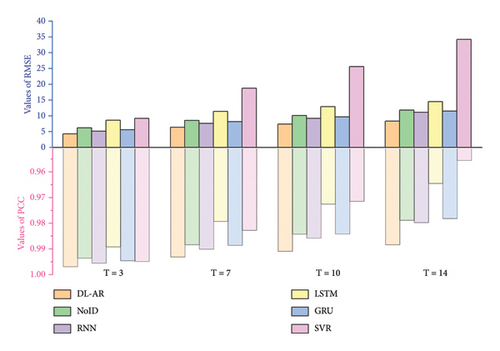
5. Determination of the Spatial Dynamic Prewarning Values
The reliable prediction result is the essential to determine the precise threshold range of early warning. Due to uncontrollable factors at the site, the evolution trend of structural states will also change accordingly. Taking the next 14 days as an example, the warning thresholds for the evolution trend of structural states are shown in Figure 10. From the figure, it can be seen that the warning values determined by the model proposed in this paper are dynamic and exhibit distinct temporal characteristics. In the figure, the dashed lines represent the range of states that the structure may exhibit under random disturbances, and the solid red line indicates the states that are most likely to occur. States within the range of the dashed line are considered normal and will not trigger warnings. Conversely, the white area outside the dashed line represents the warning zone. The probability of the structure exhibiting this state under normal disturbances is extremely low, and its occurrence will trigger a warning.
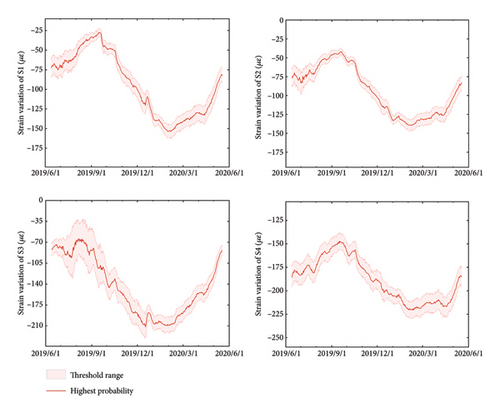
Furthermore, the evolution trend of the structural states predicted by this model is compared with the monitoring results on site, as shown in Figure 11. Obviously, the predicted evolution trend aligns well with the actual structural states. The prediction accuracy for the structural states over the next 3, 7, 10, and 14 days is presented in Table 3. Clearly, the predictive capability of the model decreases with increasing prediction time scale. This is because, with a larger time scale, there is a greater probability of unforeseen disruptive factors occurring, which in turn increases the likelihood of the structure deviating from its normal evolution trend. Nonetheless, the prediction error for the structural evolution trend within the next 14 days using the proposed model is less than 8.28 με, with a match rate of 98.8% compared to actual results.
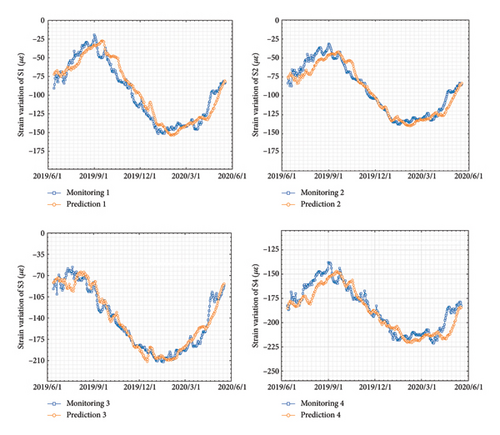
| T = 3 | T = 7 | T = 10 | T = 14 | |
|---|---|---|---|---|
| RMSE | 4.278 | 6.382 | 7.333 | 8.280 |
| PCC | 0.997 | 0.993 | 0.991 | 0.988 |
6. Conclusions
In this study, a novel prewarning method named DL-AR was proposed for detecting structural anomalies in underwater shield tunnels using deep autoregression techniques. By considering the spatial variations in structural mechanical responses and dynamically adjusting the prewarning range based on the evolving structural behaviors, the accuracy and efficiency of early-warning technology were significantly enhanced. The main conclusions of the study are summarized as follows:
DL-AR, an enhanced LSTM model, incorporates an embedding layer and a linear layer to handle input and output information, respectively. The determination of threshold ranges is constitutionally to predict the future mechanical behaviors and assess the probability of various states of tunnel structures using the spatiotemporal correlations captured by the DL-AR model. Anomalies are defined as occurrences below a probability of less than 10%. Consequently, refined threshold ranges are determined for different positions within the tunnel structure, rather than adopting a universal range for all positions. Not only for underwater shield tunnel, the proposed model is applicable for other engineering with nonlinear and dynamic mechanical behaviors.
As a case study, the DL-AR model was applied to the Wuhan Yangtze River tunnel to identify segment strain anomalies. A series of experiments were conducted to verify the reliability of model, including the reasonability of internal structure and comparing its performance with other commonly used models. The experimental results demonstrated an improved prediction accuracy for structural mechanical evaluation when considering spatial correlations. The prediction results showed near to 99% consistency with actual data, a 5% enhancement compared to classical models. The precise prediction of future mechanical behaviors of tunnel structures ensures the reliability of early-warning results, thereby establishing the credibility of the DL-AR model.
Despite its effectiveness in identifying structural anomalies in tunnel segment strain, evaluating the stability of the overall tunnel structure remains a significant challenge due to its complexity and numerous contributing factors. It is essential to conduct this research in the near future.
Conflicts of Interest
The authors declare no conflicts of interest.
Funding
This work is supported by the National Key R&D Program of China under grant 2023YFB2603605 and 2021YFC3100805, the Fundamental Research Funds for the Central Universities of China under grant JKF-20240769, the National Natural Science Foundation of China under grant U2469205, 42293355, and 51991392, Key project in Hubei Province under grant 2023BCB048, and the Science and Technology Planning Project of Tibet Autonomous Region of XZ202201ZY0021G.
Acknowledgments
This work is supported by the National Key R&D Program of China under grant 2023YFB2603605, 2021YFC3100805, the Fundamental Research Funds for the Central Universities of China under Grant JKF-20240769, the National Natural Science Foundation of China under Grant U2469205, 42293355, and 51991392, Key project in Hubei Province under grant 2023BCB048, and the Science and Technology Planning Project of Tibet Autonomous Region of XZ202201ZY0021G.
Open Research
Data Availability Statement
Data will be made available on request.



